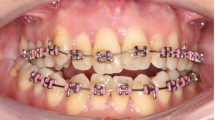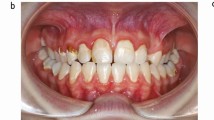Key Points
-
Discusses the issues involved in the consent process with particular reference to the adolescent patient.
-
Demonstrates the importance of capacity as one of three elements essential to a valid consent process.
-
Provides a practical approach to testing for capacity of an adolescent patient.
Abstract
The presentation of alternative treatment plans and the discussion of these options with the adolescent patient is a routine part of both general dental and specialist orthodontic practice. This article will cover the issues involved in obtaining consent for treatment from the adolescent patient and suggests a practical means, if appropriate, to ensure that these patients can give and withdraw consent for their own treatment.
Similar content being viewed by others
Log in or create a free account to read this content
Gain free access to this article, as well as selected content from this journal and more on nature.com
or
References
World Health Organization. WHO Health for the world's adolescents: A second chance in the second decade. Online information available at http://www.who.int/maternal_child_adolescent/topics/adolescence/second-decade/en/ (accessed May 2015).
Roberson A J, Kjervik D K . Adolescents' perceptions of their consent to psychiatric mental health treatment. Nurs Res Pract 2012; 2012: 379756.
Family Planning Association. Under 16s: consent and confidentiality in sexual health services. Online information available at http://www.fpa.org.uk/factsheets/under-16s-consent-confidentiality (accessed May 2015).
Gillick v West Norfolk & Wisbech Area Health Authority [1986] 3 All ER 402 (HL).
Brazier M .; Cave E . Medicine, patients and the law. 5th ed. London: Penguin, 2011.
Gabe J, Olumide G, Bury M . 'It takes three to tango': a framework for understanding patient partnership in paediatric clinics. Soc Sci Med 2004; 59: 1071–1079.
ECHR Human Rights Act 1998. Online information available at http://www.legislation.gov.uk/ukpga/1998/42 (accessed May 2015).
Bevan H K . Child law. London: Butterworths, 1989.
Elliston S . The best interests of the child in healthcare. London: Routledge, 2007.
Brazier M, Bridge C . Coercion or caring: analysing adolescent autonomy. Legal Studies 1996; 16: 84–109.
Adewumi A, Hector M P, King J M . Children and informed consent: a study of children's perceptions and involvement in consent to dental treatment. Br Dent J 2001; 191: 256–259.
McCabe M A . Involving children and adolescents in medical decision making: developmental and clinical considerations. J Paediatr Psychol 1996; 21: 505–516.
Thomas N, O' Kane C . When children's wishes and feelings clash with their best interests, Int J Children's Rights 1998; 6: 137–154.
B v NHS Trust. Butler Sloss L J [2002] ALL ER 449 at 100.
Beauchamp T L, Childress J F . Principles of Biomedical Ethics, 6th edn. New York, Oxford: Oxford University Press, 2009.
Albino J E, Lawrence S D, Lopes C E, Nash L B, Tedesco L A . Cooperation of adolescents in orthodontic treatment. J Behav Med 1991; 14: 53–70.
Wong F S, Kolokotsa K . The cost of treating children and adolescents with injuries to their permanent incisors at a dental hospital in the United Kingdom. Dental Traumatol 2004; 20: 327–333.
Janicke D M, Finney J W, Riley A W . Children's health care use: a prospective investigation of factors related to care-seeking. Med Care 2001; 39: 990–1001.
Graskemper J P . Professional responsibility in dentistry: A practical guide to law and ethics. Oxford: Wiley-Blackwell, 2011.
GDC. General Dental Council Standards for the Dental Team. 2013. Online information available at http://www.gdc-uk.org/Dentalprofessionals/Standards/Documents/Standards%20for%20the%20Dental%20Team.pdf (accessed May 2015).
United Nations. Committee on the Rights of the Child. United Nations Convention on the Rights of the Child. United Kingdom report: New York: United Nations, 1990. Online information available at https://www.gov.uk/government/policies/creating-a-fairer-and-more-equal-society/supporting-pages/the-united-nations-convention-on-the-rights-of-the-child-uncrc (accessed May 2015).
Stephens R .; Ryan F S .; Cunningham S J . Information-seeking behaviour of adolescent orthodontic patients. Am J Orthod Dentofacial Orthop 2013; 143: 303–309.
Harwood A, Harrison J E . How readable are orthodontic patient information leaflets? J Orthod 2004; 31: 210–219; discussion 201.
Patel J H, Moles D R, Cunningham S J . Factors affecting information retention in orthodontic patients. Am J Orthod Dentofacial Orthop 2008; 133: S61–S67.
Bender J L, Jimenez-Marroquin M C, Jadad A R . Seeking support on Facebook: a content analysis of breast cancer groups. J Med Internet Res 2011; 13: e16.
O'Keeffe G S, Clarke-Pearson K, Council on Communications and Media. The impact of social media on children, adolescents, and families. Paediatrics. 2011; 127: 800–804.
Heywood R .; Macaskill A .; Williams K . Informed consent in hospital practice: health professionals' perspectives and legal reflections, Medical Law Review. 2010; 18: 152–184.
Cave E . Goodbye Gillick? Identifying and resolving problems with the concept of child competence. Legal Studies 2013; 34: 103–122.
Shaw M . Competence and consent to treatment in children and adolescents. Adv Psychiatr Treat 2001; 7: 150–159.
Weithorn L A, Campbell S B . The competency of children and adolescents to make informed treatment decisions. Child Dev 1982; 53: 1589–1598.
Alderson P . Children's consent to treatment. BMJ 1994; 309: 1303.
Department of Health. Mental Capacity Act 2005. London: HMSO.
O'Brien S . Minors and refusal of medical treatment: a critique of the law regarding the current lack of meaningful consent with regards to minors and recommendations for future change. Clin Ethics 2012; 7: 67–72.
Author information
Authors and Affiliations
Corresponding author
Additional information
Refereed Paper
Rights and permissions
About this article
Cite this article
Williams, J., Atack, N. & Dhaliwal, R. Who wears the braces? A practical application of adolescent consent. Br Dent J 218, 623–627 (2015). https://doi.org/10.1038/sj.bdj.2015.497
Accepted:
Published:
Issue date:
DOI: https://doi.org/10.1038/sj.bdj.2015.497



